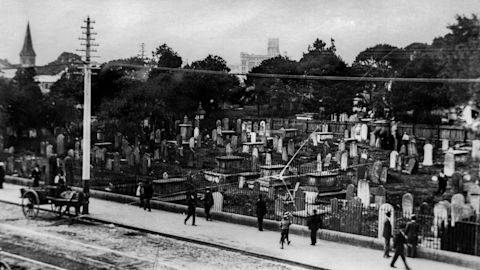Sydney Town Hall – site of Sydney’s first official cemetery, 1792–1820

Dubious management, unconsecrated ground and no formal death register – Sydney’s first cemetery may have hidden a few dark shadows.
Situated on the site of today’s Sydney Town Hall, the Old Sydney Burial Ground closed by 1820 when it was full. Soon neglected, the graveyard became a refuge for stray animals and a target for grave robbers on the hunt for leaden coffins.
A new burial ground was set aside on Devonshire Street, now the site of Central station.
With the old cemetery on prime real estate, the municipal council lobbied for 30 years to secure the land for a town hall. After political difficulties and concerns about disturbing the graves, the colonial government granted the land in 1869.
Central station – site of the Devonshire Street cemeteries, 1820–1901

Chosen for its location on the outskirts of town, the burial grounds at Elizabeth and Devonshire streets were widely used until 1866. As Surry Hills and Haymarket became bustling neighbourhoods, the cemetery became a ‘death-nest’ and a threat to public health.
With pressure to expand Sydney’s existing rail network, the site was earmarked by the state government for the new Central station. Relatives had a strict 2 months to claim bodies, leaving 30,000 unclaimed and moved by the government. Most of the site is underneath today’s station platforms.
The Mint – site of Sydney’s first general hospital, 1816–1853

Sydney’s first general hospital, also known as the Rum Hospital, was a grand scheme initiated by Governor Lachlan Macquarie and built with an enterprising deal.
The developers of the 3-wing hospital (merchants Alexander Riley and Garnham Blaxcell and surgeon D’Arcy Wentworth) financed its construction.
In return they had a monopoly on importing rum and spirits.
The large central wing was designed to house and treat up to 200 ill convicts. Early scenes in the hospital were chaotic and the level of care was determined by the varying medical experience of the staff.
The Royal Sydney Mint we know today opened in 1855.
St Vincent's Hospital, 1870

St Vincent’s hospital moved to this site in 1870 from its first location in nearby Potts Point.
The hospital was founded by 5 Irish nuns from the Sisters of Charity. Three of the hospital’s founders were professional nurses trained in France. Their hospital was opened as a free hospital for all people but with special attention for the poor including the inmates of the nearby Darlinghurst Gaol and their families.
Sydney Hospital, Macquarie Street, 1881

When convict transportation ended, the central wing of the Rum Hospital became the Sydney Infirmary and Dispensary. It was the only hospital for Sydneysiders until 1857 when St Vincent’s opened.
The central wing was beset with building defects and rising damp, which was demolished in 1876.
The grand sandstone Sydney Hospital buildings that front Macquarie Street today opened in 1894.
Crown Street Women’s Hospital, 1893–1983

Once the state’s largest maternity hospital, Crown Street Women’s Hospital aimed to lift medical standards for maternity care and women’s health.
Established in 1893, it was known for its innovative health practices, including Australia’s first alternative birth centre, its leading obstetricians and its army of volunteers.

Located in then working-class Surry Hills, the hospital cared for Sydney’s marginalised women – the poor, the unmarried, Aboriginal and immigrant women and drug-dependent women. The decision to close it down in 1983 saw demonstrations in the streets.
Published 22 August 2018, updated 11 September 2018



